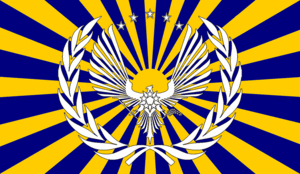President of the Californian Empire
| President of the Californian Empire | |
|---|---|
 Flag of the Californian Empire | |
| Style |
|
| Status | Head of Government |
| Abbreviation | Pres., POTCE |
| Member of |
|
| Reports to | Fiora S. A. Dévnostraéva |
| Residence | The Presidential Estate |
| Seat | Los Angeles, N.C.D. |
| Nominator |
|
| Appointer | Electoral College |
| Term length | Five years, unlimited renewals |
| Constituting instrument | Californian Empire Constitution; Article 3, §3 & §4 (2300) |
| Formation | June 1, 1999 |
| First holder |
|
| Deputy | Vice President of the Californian Empire |
| Salary | Ð325,000 annually |
The President of the Californian Empire is the head of government of Californian Empire. The president with the consent of the Empress, exercises limited power over the executive branch of the federal government and is the Second-In-Command of the Californian Empire Armed Forces.
Article 3 of the 2300 Californian Empire Constitution vests the limited executive power in the president and charges him/her with the execution of federal law, alongside the responsibility of appointing federal executive, diplomatic, regulatory, and judicial officers and concluding treaties with foreign powers with the advice and consent of the Parliament. The president is further empowered to grant federal pardons and reprieves and to convene and adjourn the Parliament under extraordinary circumstances. The power of the president and the federal government has grown substantially. The President, despite possessing no formal legislative powers beyond signing or vetoing Parliament passed bills, is largely responsible for dictating the legislative agenda of his/her party and the foreign and domestic policy of Californian Empire.
Powers and Roles
Article 3: Executive Power
Article 3, Section 3 states "The head of the government of the Californian Empire shall be the President."
Article 3, Section 4 The first power the Constitution confers upon the president is the veto. The Presentment Clause requires any bill passed by the Parliament to be presented to the president before it can become law. Once the legislation has been presented, the president has three options:
- Sign the legislation; the bill then becomes law.
- Veto the legislation and return it to Parliament, expressing any objections; the bill does not become law, unless the Parliament votes to override the veto by a super-majority.
- Take no action. In this instance, the president neither signs nor vetoes the legislation. After 10 days, not counting Sundays, two possible outcomes emerge:
- If the Parliament is still convened, the bill becomes law.
- If the Parliament has adjourned, thus preventing the return of the legislation, the bill does not become law.
The President cannot, however, veto portions of laws.
War and foreign affairs powers
With the consent of the Empress, the President is responsible for conducting war, approved by the Parliament for operations lasting longer than 60 days. The President is the Second-In-Command of the Californian Empire Armed Forces, which is one of the most important duties of the Office of the President of the Californian Empire. The President is the secondmost authority on how the military is used, however the Parliament controls its budget, so Presidents cannot simply act unilaterally when it comes to conducting war.
Along with the armed forces, the president also directs C.E. foreign policy. Through the Department of State and the Department of Defense, the president is responsible for the protection of Californians abroad and of foreign nationals in the Californian Empire. The president decides whether to recognize new nations and new governments, and negotiates treaties with other nations, which become binding on the Californian Empire when approved by two-thirds vote of the Senate.
Although not constitutionally provided, presidents also sometimes employ "executive agreements" in foreign relations. These agreements frequently regard administrative policy choices germane to executive power; for example, the extent to which either country presents an armed presence in a given area, how each country will enforce copyright treaties, or how each country will process foreign mail. However, the 23th century witnessed a vast expansion of the use of executive agreements, and critics have challenged the extent of that use as supplanting the treaty process and removing constitutionally prescribed checks and balances over the executive in foreign relations. Supporters counter that the agreements offer a pragmatic solution when the need for swift, secret, and/or concerted action arises.
Administrative powers
The president is the head of the executive branch of the federal government and is constitutionally obligated to enforce legislation. The executive branch has over four million employees, including members of the military. Presidents make numerous executive branch appointments Ambassadors, members of the Cabinet, and other federal officers, are all appointed by a president. All appointments must be approved by the Parliament when made during a legislative session.
The power of a president to fire executive officials has become a contentious political issue. Generally, a president may remove purely executive officials at his discretion. However, the Parliament can curtail and constrain a president's authority to fire commissioners of independent regulatory agencies and certain inferior executive officers by statute.
The president additionally possesses the ability to direct much of the executive branch through executive orders that are grounded in federal law or constitutionally granted executive power. Executive orders are reviewable by federal courts and can be superseded by federal legislation.
To manage the growing federal bureaucracy, Presidents have gradually surrounded themselves with many layers of staff, organized into the Executive Office of the President of the Californian Empire. Within the Executive Office, the President's innermost layer of aides (and their assistants) are located in the Presidential Estate, Los Angeles, N.C.D..
Juridical powers
The president also has the power to nominate federal judges, including members of the Californian Empire courts of appeals and the Supreme Court of Californian Empire. However, these nominations do require Parliament confirmation. Securing their approval can provide a major obstacle for presidents who wish to orient the federal judiciary toward a particular ideological stance. Presidents may also grant pardons and reprieves.
Two doctrines concerning executive power have developed that enable the president to exercise executive power with a degree of autonomy. The first is executive privilege, which allows the president to withhold from disclosure any communications made directly to the president in the performance of executive duties. The state secrets privilege allows the president and the executive branch to withhold information or documents from discovery in legal proceedings if such release would harm national security.
Legislative Role
The Constitution's Ineligibility Clause prevents the President (and all other executive officers) from simultaneously being a member of the Parliament. Therefore, the president cannot directly introduce legislative proposals for consideration in the Parliament. However, the president can take an indirect role in shaping legislation, especially if the president's political party has a majority. For example, the president or other officials of the executive branch may draft legislation and then ask senators, delegates or representatives to introduce these drafts into the Parliament. The president can further influence the legislative branch through constitutionally mandated, periodic reports to Parliament. These reports may be either written or oral, but are known as the State of the Empire address, which often outlines the president's legislative proposals for the coming year.
The president may convene the Parliament. If members cannot agree on a date of adjournment, the president may appoint a date for the Parliament to adjourn.
Ceremonial Roles
The presidency holds the president as one of the nation's premier celebrities. Some argue that images of the presidency have a tendency to be manipulated by administration public relations officials as well as by presidents themselves. One critic described the presidency as "propagandized leadership" which has a "mesmerizing power surrounding the office." As a celebrity, the President comes under scrutiny not only in domestic affairs but internationally, as the President represents the entirety of the state at home and abroad.
Presidents are also responsible for giving military and ceremonial awards, which are done around Christmas time traditionally at the Winter Ball (unless otherwise stated, the Empress does this great duty).
List of Presidents of the Californian Empire
- Symbols
Denotes Acting President
| # | Portrait | President | Took office | Left Office | Party | Terms | Election | Previous Office | Vice President(s) | |
|---|---|---|---|---|---|---|---|---|---|---|
| 1 | 
|
Selene A. M. Dévnostraéva | August 1, 1999 | November 1, 2240 Resigned[1] |
National Democratic Democratic Socialist |
48 (241 years, 3 months) |
2005 2010 2015 2020 2025 2030 2035 |
Admiral, C.E. Navy, CEO | Alexa S. Vassaretti-Dévnostraéva | |
| National Democratic Libertarian |
2040 2045 2050 2055 2060 2065 2070 2075 2080 2085 2090 2095 2100 2105 2110 2115 2120 | |||||||||
| Libertarian National Democratic Progressive |
2125 2130 2135 2140 2145 2150 2155 2160 2165 2170 2175 2180 2185 2190 2195 2200 | |||||||||
| National Democratic Libertarian |
2205 2210 2215 2220 2225 2230 2235 | |||||||||
| National Democratic Democratic Socialist[2] |
2240 | Office vacated | ||||||||
| 2 | 
|
Alexa S. Vassaretti-Dévnostraéva (Acting) | November 1, 2240 | November, 18, 2240 | 0 (17 days) |
Vice President | ||||
| Alexa S. Vassaretti-Dévnostraéva | November 18, 2240 | August 24, 2259 Resigned[3] |
4 (18 years, 9 months, 7 days) |
2245 2250 |
Lindsey A. DeWinter | |||||
| National Democratic Democratic |
2255 | Jennifer A. Jourgensen-Dévnostraéva | ||||||||
| 3 | 
|
Jennifer A. Jourgensen-Dévnostraéva (Acting) | August 24, 2259 | August 27, 2259 | 0 (3 days) |
Vice President | Office vacated | |||
| Jennifer A. Jourgensen-Dévnostraéva | August 27, 2259 | November 1, 2261 Resigned[4] |
National Democratic Democratic |
1 (2 years, 2 months, 6 days) |
2260 | Lindsey A. DeWinter Samantha R. Carter | ||||
| Natalya S. Kensington | ||||||||||
| 4 | 
|
Natalya S. Kensington | November 1, 2261 | November 19, 2273 Impeached[5] |
2.5 (12 years, 18 days) |
Vice President | Office Vacated | |||
| Democratic | 2265 | Cynthia R. Breckinridge Anya M. Demetraevik | ||||||||
| Natalya S. Kensington (de jure) Lindsey A. DeWinter (de facto) |
March 23, 2268[6] | October 13, 2273 Executed[7] |
Socialist | 1 (5 years, 6 months, 13 days)[8] |
Lindsey A. DeWinter Office vacated | |||||

|
2270 | Vice President | Vacant | |||||||

|
Selene A. M. Dévnostraéva (Acting) | November 19, 2273[9] | November, 1, 2275 | Liberal Conservative Party Conservative Democracy Alliance Liberal Democratic Party Californian Solidarity Coalition Constitutional Democratic Party Californian Conservative Party |
1 (1 year, 11 months, 14 days) |
President | ||||
| 5 | 
|
Selena K. H. DeWinter-Dévnostraéva | November 1, 2275 | Incumbent | Liberal Conservative Party Conservative Democracy Alliance |
6 (26 years, 7 months, 29 days) |
2275 2280 |
Speaker of the Chamber of Delegates | Victoria S. Moynahan | |
| Liberal Democratic Party Californian Solidarity Coalition |
2285 2290 |
Lillian J. D'Agostino | ||||||||
| Californian Conservative Party | 2295 2300 |
Vivienne M. Girardeaux | ||||||||
Timeline

References
- ↑ Upon being re-elected on 1 November 2240, she immediately resigned the presidency to her Vice President.
- ↑ This would be the last time the Californian Democratic Socialist Party would compete as a united party before its split into the Democratic and Socialist Party.
- ↑ Originally listed as having been assassinated as a result of the attack in 2259 orchestrated by the Socialist Party of California, resulting in the destruction of CGP Tower 1. This first attack resulted in the CSP being designated a terrorist entity within the Californian Confederation.
- ↑ Resigned, after strong indications within Parliament to oust her with a vote of no confidence.
- ↑ Subsequent to the National Assembly trial after evidence came to light of her actions during the late stage of the coup attempt against her, Natalya S. Kensington was removed from office.
- ↑ Initially took over as acting president, under the pretense that Natalya Kensington was in recovery after a major medical procedure.
- ↑ Attempted to take the presidency through a coup d'état against Natalya Kensington.
- ↑ Rather than to lend the administration of Lindsey A. DeWinter any legitimacy, the dates of DeWinter's unofficial term as President are defined more for the purposes of clarification, as said term occurred contemporaneously during the terms of the legitimate President, Natalya S. Kensington.
- ↑ Nominated via supermajority in Parliament on Selena K. H. DeWinter-Dévnostraéva's behalf to serve as the leader of a caretaker government on November 1, 2273.
